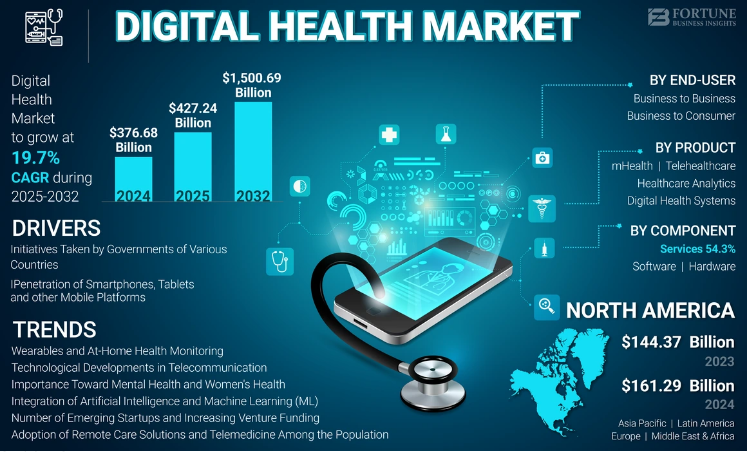Market Overview
The mena healthcare services market is experiencing transformative growth, driven by healthcare technology innovations, expanding digital ecosystems, and a rising focus on preventive and personalized medicine. Between 2024 and 2032, the industry is projected to expand significantly, supported by higher healthcare budgets, evolving patient expectations, and growing investments in infrastructure and research.
Demographic shifts—including aging populations, urbanization, and the rising prevalence of chronic diseases—are further accelerating demand for advanced healthcare services and solutions worldwide.
mena healthcare services market represents a broad set of products, solutions, and services that enhance care delivery, improve safety, and ensure compliance. These solutions are crucial for reducing risks, protecting patients, enhancing diagnostic and treatment efficiency, and maintaining regulatory adherence.
Continue reading for more details: https://www.fortunebusinessinsights.com/jp/mena-healthcare-services-market-109840
Key Market Drivers
Rising Patient Safety Concerns – Demand for tools that prevent medical errors and infections.
Technological Advancements – Integration of AI, analytics, and automation for efficiency.
Healthcare Expenditure Growth – Investments in infrastructure upgrades by governments and private players.
Regulatory Pressure – Strict global safety standards driving adoption.
Expansion in Emerging Markets – Improved healthcare infrastructure in Asia-Pacific, Latin America, and Africa.
Market Segmentation
The mena healthcare services market can be segmented as follows:
By Type of Service: The hospital care segment dominated due to comprehensive service offerings and rising hospital infrastructure supported by privatization. Physician & clinical services are expected to grow at a high CAGR due to increasing specialty clinics, while dental and diagnostic services held significant shares due to rising procedures and disease burden. Other services like home healthcare and physiotherapy are gaining traction owing to chronic disease management.
By Funding Source: Public health insurance led the market, driven by government initiatives to expand insurance coverage. Private health insurance is expected to grow rapidly due to increasing foreign investment and infrastructure development. Out-of-pocket spending remains prominent in countries with limited public insurance access.
By Type of Care: Inpatient care dominated due to the rising prevalence of chronic conditions requiring long-term treatment. Outpatient care is projected to grow faster due to increased focus on preventive care, diagnostics, and the expansion of day surgery centers.
By Facility Type: Hospitals held the largest share due to major investments in new facilities and chronic disease treatment needs. Clinics are growing due to the emergence of specialty care, while diagnostic imaging centers and pathology labs are expanding in response to increased demand for disease diagnosis.
Competitive Landscape
The market is highly competitive, with multinational corporations and regional players adopting strategies such as:
Research & Development (R&D) investments
Mergers & acquisitions
Strategic partnerships and global expansions
Key Players:
- DR SULAIMAN AL HABIB(Saudi Arabia)
- Aster DM Healthcare (UAE)
- Middle East Healthcare Company (Saudi German Health) (UAE)
- Burjeel Holdings (UAE)
- elaj group (Saudi Arabia)
- Mouwasat Dammam (Saudi Arabia)
- Cleopatra Hospitals Group (Egypt)
- Dallah Health (UAE)
- Integrated Diagnostics Holding (U.K.)
- Pure Health (UAE)
Regional Insights
North America: Largest market, supported by advanced healthcare systems, strict regulations, and high patient safety awareness.
Europe: Second-largest market, emphasizing compliance, sustainability, and innovation.
Asia-Pacific: Fastest-growing region, driven by healthcare spending, infrastructure expansion, and a large patient base.
Latin America & Middle East & Africa: Steady growth due to government initiatives and cross-border collaborations.
Challenges
High Costs – Advanced solutions remain expensive for smaller hospitals in developing regions.
Low Awareness – Limited understanding of mena healthcare services market benefits in certain countries.
Alternatives – Competing tools (manual or biological indicators) limit adoption in some markets.
Regulatory Complexity – Compliance with varying global standards is a challenge for multinationals.
Emerging Trends
Digital Transformation – Adoption of cloud-based healthcare platforms and telemedicine integration.
Artificial Intelligence – Predictive analytics and AI-driven decision-making tools.
Personalized Medicine – Custom healthcare solutions leveraging genetic and patient data.
Preventive Healthcare – Increased focus on infection prevention and risk reduction.
Sustainability – Eco-friendly and resource-efficient healthcare solutions gaining traction.
Market Outlook
The outlook for the mena healthcare services market remains highly positive. With consistent growth projections, technological advancements, and expanding adoption across developed and emerging economies, mena healthcare services market will continue to play a central role in shaping modern healthcare systems. Companies that prioritize innovation, affordability, and sustainability will gain a competitive edge in this rapidly evolving market.
Frequently Asked Questions (FAQs)
What was the size of the mena healthcare services market in 2024 ? USD 241.13 billion
What is the expected CAGR during Forecast – 2032? 6.9%
Which technologies are driving growth? AI, automation, digital ecosystems
- What trends are transforming the mena healthcare services market landscape? Key trends include AI-IoT integration, blockchain adoption, low-code tools, and the ethical tech movement.







